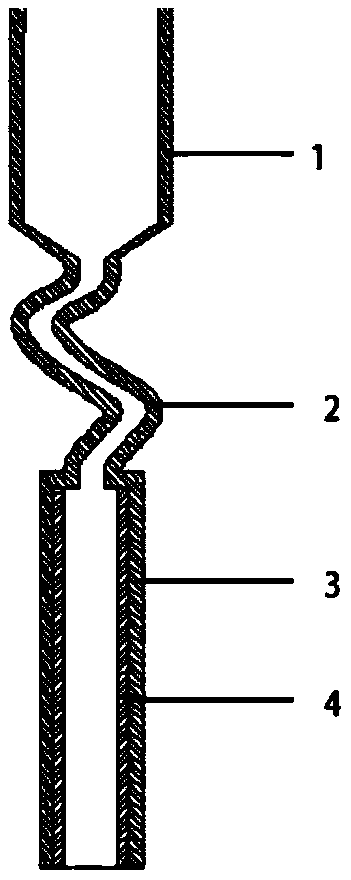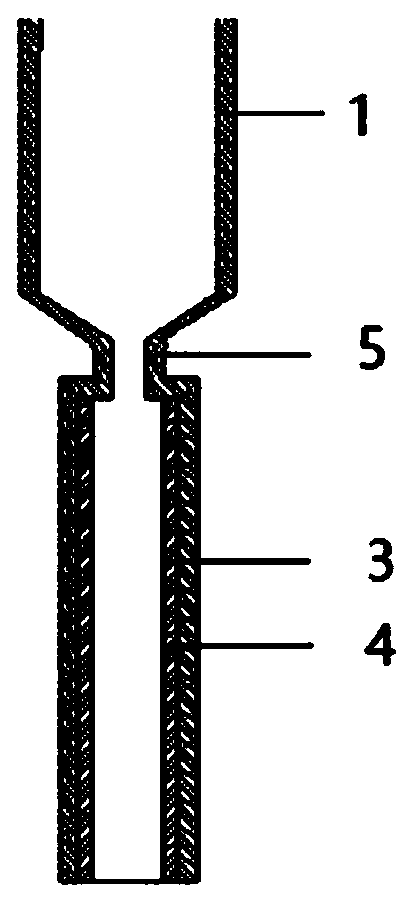Method for preparing single-crystal high-temperature alloy from seed crystal subjected to solid-solution treatment
A high-temperature alloy and solution treatment technology, applied in the direction of self-solidification, single crystal growth, single crystal growth, etc., can solve the problems of increased preparation cost, mechanization degree of mold shell preparation and overall precision reduction, etc., to improve the degree of mechanization and The effect of assembly accuracy, simplified structure and cost reduction
- Summary
- Abstract
- Description
- Claims
- Application Information
AI Technical Summary
Problems solved by technology
Method used
Image
Examples
Embodiment 1
[0043] This example is a method for preparing three nickel-based single crystal superalloy blade samples with a orientation deviation angle of 0° by using solution treated seed crystals.
[0044] The nickel-based single crystal superalloy is composed of Cr, Mo, Al, Co, W, Ti, C, B and Ni, wherein: the alloy composition is 9.5% for Cr, 4.0% for Mo, 5.8% for Al, and 5.8% for Ti. 2.0, Co is 5.0%, W is 5.5%, C≤0.02%, B≤0.02%, and the rest is Ni. The stated percentages are all mass percentages.
[0045] The concrete process of this embodiment is:
[0046] Step 1, solid solution treating the single crystal preform.
[0047] An analysis sample was cut out from the single crystal preform, and the average primary dendrite spacing of the analysis sample was determined to be 273 μm using a metallographic microscope. Use a synchronous thermal analyzer to determine that the initial melting temperature of the analyzed sample is 1278°C, and the solidus temperature is 1321°C, with 1268°C ...
Embodiment 2
[0065] This example is to prepare 4 nickel-based single crystal superalloy plate samples with a orientation deviation angle of 15°. The alloy is composed of Cr, Mo, Al, Co, W, Re, Ta, Hf, C, B and Ni composition, wherein: the alloy composition is 4.3% of Cr, 9.0% of Co, 2.0% of Mo, 8.0% of W, 7.5% of Ta, 2.0% of Re, 5.6% of Al, 0.1% of Hf, and Ti of 1.0%, C≤0.02%, B≤0.02%, the rest is Ni. The stated percentages are all mass percentages.
[0066] The specific steps are:
[0067] Step 1, solid solution treating the single crystal preform.
[0068] An analysis sample was cut from the single crystal preform, and the average primary dendrite spacing of the analysis sample was determined to be 269 μm using a metallographic microscope. Use a synchronous thermal analyzer to measure the initial melting temperature of the analyzed sample to be 1290°C, the solidus temperature to be 1331°C, take 1280°C as the lower limit of the solution treatment temperature range, and take 1321°C as ...
Embodiment 3
[0086] This example is to prepare 5 rod-shaped samples of nickel-based single crystal superalloy with orientation deviation angle of 40°, the alloy is composed of Cr, Mo, Al, Co, W, Re, Ta, Hf, C and Ni, Among them: the alloy composition is 3% of Cr, 1% of Mo, 6% of Al, 12% of Co, 6% of W, 4% of Re, 12% of Ta, 0.2% of Hf, C≤0.02%, B≤0.02%, the rest is Ni. The stated percentages are all mass percentages.
[0087] The specific steps are:
[0088] The concrete process of this embodiment is:
[0089] Step 1, solid solution treating the single crystal preform.
[0090] An analysis sample was cut from the single crystal preform, and the average primary dendrite spacing of the analysis sample was determined to be 276 μm using a metallographic microscope. Use a synchronous thermal analyzer to determine that the initial melting temperature of the analyzed sample is 1303°C, and the solidus temperature is 1344°C, with 1293°C as the lower limit of the solution treatment temperature r...
PUM
| Property | Measurement | Unit |
|---|---|---|
| diameter | aaaaa | aaaaa |
| solidus temperature | aaaaa | aaaaa |
| diameter | aaaaa | aaaaa |
Abstract
Description
Claims
Application Information
 Login to View More
Login to View More - R&D
- Intellectual Property
- Life Sciences
- Materials
- Tech Scout
- Unparalleled Data Quality
- Higher Quality Content
- 60% Fewer Hallucinations
Browse by: Latest US Patents, China's latest patents, Technical Efficacy Thesaurus, Application Domain, Technology Topic, Popular Technical Reports.
© 2025 PatSnap. All rights reserved.Legal|Privacy policy|Modern Slavery Act Transparency Statement|Sitemap|About US| Contact US: help@patsnap.com



